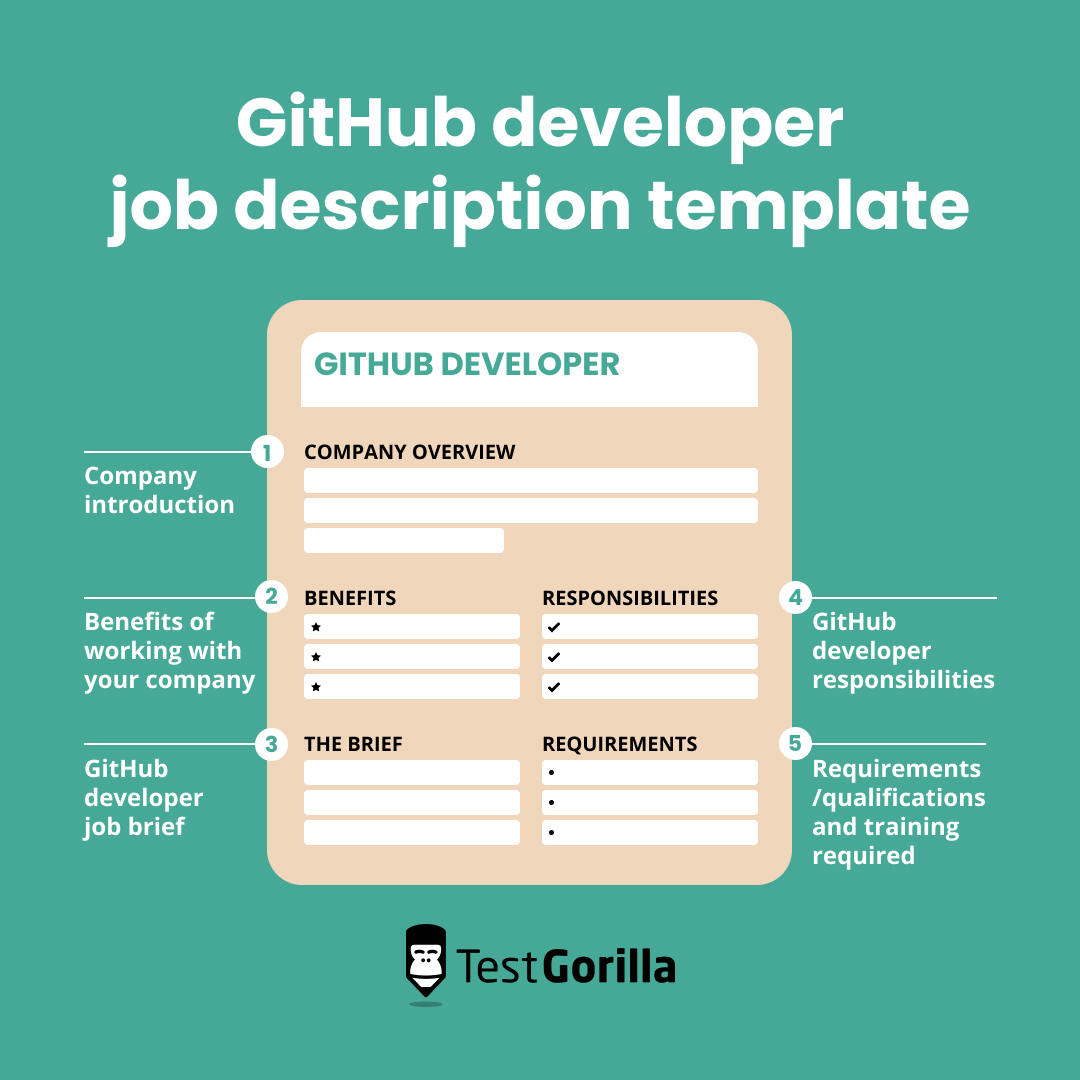Hiring a programmer who knows how to use GitHub is one of the best ways to get your company’s software development started on the right foot. Many top developers use GitHub to manage their code and collaborate with other programmers.
Candidates with extensive GitHub experience can help you start a codebase for your business, keep it organized, and ensure your developers work together as your software team grows. However, employing a developer lacking relevant knowledge can leave you with an unmanageable codebase other programmers aren’t able to build on.
Hiring the best developer for your business starts with writing a compelling job ad. We’ll walk through how to write a GitHub developer job description and share a template you can use to launch your hiring campaign.
Table of contents
- What is a GitHub developer?
- Key skills to look for in GitHub developers
- How to write an effective GitHub developer job description
- GitHub developer job description template
- Four things to avoid when writing a job description for GitHub developers
- Next steps: Attracting and assessing GitHub developer candidates
- FAQs
- Hire the best GitHub developer with TestGorilla
What is a GitHub developer?
A GitHub developer is an individual who has experience using GitHub to build codebases, version-control code, and collaborate with other software engineers.
GitHub uses the Git version control system to automatically track code changes and enable programmers to work in a sandbox environment without disrupting live software.
Developers use GitHub to manage code in a wide variety of programming languages, including Python, JavaScript, Ruby, and many others.
Key skills to look for in GitHub developers
Here are some important skills to look for when hiring a GitHub developer:
Programming experience: GitHub developers should be proficient in one or more popular programming languages, such as CSS, Python, Ruby, Tensorflow, or others. Our guide to hiring a software developer explains what each of these programming languages is used for.
Git proficiency: Git is a version control system designed for code. Programming candidates need to know how to use Git to create code repositories, manage code versions, and push new code to live software.
GitHub experience: Candidates must have experience using GitHub to manage and share code repositories created using Git.
Organization: Developers need excellent organizational skills to keep code repositories and versions cataloged within GitHub.
Clean coding: Programming candidates must be able to write clean code that’s reproducible and error-free.
Collaboration: Developers often use GitHub to share code within teams. Candidates should have excellent interpersonal skills to facilitate teamwork on large projects.
The best insights on HR and recruitment, delivered to your inbox.
Biweekly updates. No spam. Unsubscribe any time.
How to write an effective GitHub developer job description
An effective and engaging job description will help you pinpoint the talent your business needs. Here, we discuss a few points to take into consideration as you craft your job post.
Describe the projects you want to accomplish
GitHub developers work on a vast range of projects, such as building static websites, developing scalable e-commerce stores, and training AI models. Describing the types of projects you have in mind for a developer will help you attract candidates who are enthusiastic about the work your business wants to accomplish.
Specify required programming languages
Depending on the role, developers can use GitHub to manage and share code written in dozens of different programming languages.
For example, creating simple websites may only require using a single language, while other projects, such as building e-commerce sites, may use multiple programming languages. So, specify what your candidate needs to be proficient in.
Discuss GitHub certifications
GitHub offers certifications that developers can achieve to demonstrate their expertise in using Git version control tools, managing code repositories, and securely sharing code. Make it clear whether you require applicants to have GitHub certifications or that candidates will be encouraged to get certified once hired.
Include soft skills
Specify the soft skills needed for the GitHub role at your company. For example, if the person you hire will work with a team of software engineers or closely with UI/UX designers, then strong collaboration skills are essential.
Additionally, if you plan to offer a remote or hybrid work arrangement, candidates should be able to demonstrate excellent time management skills and have experience working remotely.
GitHub developer job description template
Use our customizable template to write a compelling job description for a GitHub developer.
Company introduction
Start by introducing your company, including when it was launched, how many employees it has, and what products or services it’s best known for. You can also mention where your business has offices and whether it has won industry awards.
Stand out from the get-go by discussing the importance of the GitHub developer role in your business. For example, if hiring a developer will unlock growth or increase productivity, state that in your introduction.
Benefits of working with [your company]
Following the introduction, list the benefits that a GitHub developer will receive at your company. Include monetary incentives like paid time off, health insurance, and retirement programs. You should also include remote or hybrid work arrangements as a perk if your company offers them.
GitHub developer job brief
[Company name]
Job Title: [For example, Front-End Software Developer, Software Engineer, [programming language] Developer]
Reports to: [For example, Senior Software Developer, Lead Software Engineer, or Chief Technology Officer]
Position Type: [Full-time or part-time; employee or independent contractor]
Location: [Remote, hybrid, or on-site]
[Compensation details]
GitHub developer responsibilities
Write error-free [programming language] code
Build and manage codebases using GitHub
Collaborate with [software development team, UI/UX designers, etc.]
Optimize code for performance and security
Report project updates to project managers and senior developers
Requirements/qualifications and training required
A [bachelor’s or master’s degree] in computer science, software engineering, or a similar field – OR equivalent work experience
[2+] years’ experience as a [programming language] developer
Experience using GitHub
Four things to avoid when writing a job description for GitHub developers
Avoid these four common mistakes in your GitHub developer job description to ensure you attract top candidates to your role.
1. Not focusing on programming experience
GitHub is most useful when your business has a codebase of clean, unique, and project-specific code. The candidate you hire must be an expert in one or more programming languages.
Make sure your job description covers the programming languages you want developers to be proficient in and how much coding experience they should have.
2. Ignoring teamwork skills
One of the reasons GitHub is so popular among developers is that it enables seamless collaboration on code.
Your job description needs to highlight the soft skills developers should have, such as strong communication and the ability to prioritize tasks. This is especially important if the developer you hire will be joining an existing software team.
3. Using biased language
Inadvertently using biased language in your job description can discourage qualified developers from applying for your role and put your business out of compliance with equal-opportunity employment laws.
Biased language includes phrases that have gendered connotations. Words like “competitive,” “aggressive,” and “driven” are often interpreted as signaling to male candidates and can discourage female developers from applying.
4. Not highlighting your company’s values
Many developers seek jobs at businesses that share their values. Explain what causes your company embraces beyond simply making money and discuss the programs it has in place to support those causes. If your business has a mission statement, include it in your company introduction.
Next steps: Attracting and assessing GitHub developer candidates
Once your job description is finished, you can post it to online job boards, social media, and LinkedIn to begin soliciting applications. Expand your search by networking at software conferences or hiring a recruiter.
After applications roll in, use a pre-employment screening platform like TestGorilla to choose which applicants to advance through your hiring process. TestGorilla offers more than 300 tests so you can screen GitHub developers and find the best candidates.
TestGorilla’s library includes role-specific tests for the Git version control system and the GitHub platform. It also includes a wide variety of programming skills tests for languages such as:
Python
JavaScript
Node.js
Ruby
Rust
Tensorflow
R
TestGorilla enables you to evaluate developers’ soft skills with tests for communication, attention to detail, critical thinking, and more. It also offers personality tests that provide insight into how candidates will fit in with your current teams.
You can mix and match up to five programming, soft skill, and personality tests to create a bespoke assessment, as well as add custom one-way video interviews. Our guide to front-end developer interview questions is a great resource for determining what to ask your candidates.
FAQs
Do developers need to know GitHub?
GitHub is the most widely used platform for hosting code repositories created with the Git version control system. While developers can write code without using GitHub, it’s highly recommended to hire a programmer who knows how to use it. Code saved on GitHub is organized and shareable, enabling developers to work together on complex projects.
Can I hire a developer on GitHub?
GitHub doesn’t offer a way to advertise jobs or hire a developer directly on the platform. However, you can use GitHub to find developers who have the skills you need and who are experts at managing code on this platform. Once you find a qualified developer on GitHub, you can reach out to them directly and invite them to apply for your role.
Hire the best GitHub developer with TestGorilla
A GitHub developer can help you manage your company’s code and facilitate collaboration with your software team. A strong job description is key to attracting talented applicants and should explain what kind of programmer you want to hire and detail the benefits of working for your business.
TestGorilla enables you to select the best candidates. Our platform offers an expert-designed GitHub test as well as programming skills tests, soft skills tests, and personality tests. Plus, you can customize your assessments with one-way interview questions to build a full profile of your prospective developers.
Create your first TestGorilla assessment for free or sign up for a product demo to hire the best GitHub developer today.
You've scrolled this far
Why not try TestGorilla for free, and see what happens when you put skills first.




















